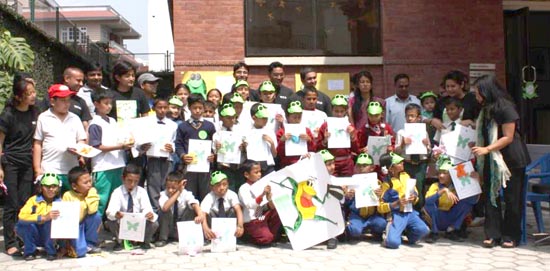 |
| A garden lizard basking above the litters |
To tell the truth, I took an avid interest in amphibians and reptiles after my undergrad studies and basically as a stay-at-home guy. Thanks to the few TV stations that featured programs on herps !! Dr. Brady Barr's herping expeditions of reckless catch poking his head inside burrows were something that had left an indelible impression on me. I began exploring these historically tough species through whatever information I came across at that time. TV shows, Books, Internet, Journals, Magazines, conversation with relevant people and so forth. But call it irony or else?, I used to get jitters as my greatest fear in childhood was none other than spooky reptiles. Geckos, Snakes, Garden Lizards would scare the life out of me! Anyway, I overcame the ignorance and fear of my growing interest in studying herps year after year.
My first official herping started out when I was pursuing Master's degree in Environmental Science. In 2011, some of our batch-mates including me had the opportunity to participate in 'Tiger & Prey Base Occupancy Survey at Banke National Park conducted by WWF Nepal. It was only a year after since establishment of Banke National Park in May 2010. I was very enthusiastic about the fieldwork as this was my first ever travel in the woods researching flora and fauna. I conceived the idea of preparing a checklist of herps from the information (visual observation and photographs) we collected. There were three to four groups, each including five individuals. After 20 days of survey, the first herpetological checklist of Banke National park was established.
Nine species; amphibians (2 species) and reptiles (7 species) were recorded from Banke National Park. Observations were carried out through opportunistic sampling and the finds captured in cameras; SONY CYBER-SHOT DSC-T700 of focal length 6.18-24.7 mm and CANON POWERSHOT SX20 IS.
SN SPECIES
|
FAMILY
|
No. OF INDIVIDUAL
|
|
1
Duttaphrynus
melanostictus
2
Euphlyctis cyanophlyctis
3
Calotes versicolor
versicolor
4
Laudakia tuberculata
5 Sitana sivalensis
6 Hemidactylus frenatus
7 Lygosoma albopunctatum
8 Dendrelaphis tristis
9 Naja naja
|
Bufonidae
Ranidae
Agamidae
Agamidae
Agamidae
Gekkonidae
Scincidae
Colubridae
Elapidae
|
1
1
1
2
1
1
1
1
1
|
|
Total Individuals
|
10
|
Species Accounts:
1. Duttphrynus melanostictus Schneider, 1799

Black-spined Toad
A black-spined toad (Duttaphrynus melanostictus) was photographed by Mr. Ankit Joshi (participant of the survey) on the way to Haukhola, the northern fringes of Banke National Park. The toad was about to be swallowed by a spectacled cobra (Naja naja) when the crew unknowingly was moving ahead in the trail. Luckily, no injury sustained but the toad succumbed to the venom of cobra finally. Secretions (slight reddish) can be seen at the dorsal part of the toad.
2. Euphlyctis cyanophlyctis (Schneider, 1799)
 |
| Skittering frog |
These frogs are the most abundant throughout its distribution in Nepal. Mostly inhabiting ponds, streams, large rivers, rice fields, and warm tropical/subtropical zones.
3. Calotes versicolor versicolor (Daudin, 1802)
 |
| Common garden lizard |
4. Laudakia tuberculata (Hardwicke & Gray, 1827)
 |
| Kashmir Rock Agama |
I've seen many of the rock lizards in the mountains and uplands of the Himalayan region but to my surprise, the first observation I did with this species was around the foothills of Chure. I didn't record the altitude then which now could delineate its lower range of distribution. One of the robust agamas could be seen basking on open rocky habitats, cultivation, settlements, etc.
.JPG) |
| Siwalik sitana |
The endemic lizard to Nepal, Sitana sivalensis is unique in morphology and anyone seeing it for the first would surely fall in love...lol. It was observed beneath litters at Sal (Shorea robusta) forest. The black diagonal longitudinal markings are signature in the Sitana genus.
6. Hemidactylus frenatus (Schlegel in: Dumeril & Bibron 1836)
 |
| Asian house gecko |
Called 'Mausuli' in Nepali, these house geckos are prevalent in the lowlands of Nepal and have wider global distribution. They are carnivorous and can be heard 'tick tick tick tick" sound around in & out of the house.
7. Lygosoma albopunctatum (Gray, 1846)
 |
| Brown dwarf skink |
These are called 'Bhangemungro' in Nepali and has a glossy body like a snake with limbs resembling a lizard. Actually, it's a skink! It is common in Nepal's lowlands inhabiting the Terai Sal forest with grasslands. Active during the day and some literature refer to it being crepuscular. If you hear someone screaming 'sarpa ko mama' in villages then be sure it'd be a skink. I can't be sure of the kinship with the snakes though!
8. Dendrelaphis tristis (Daudin, 1803)
 |
| Common bronze back tree snake |
An arboreal snake, Bronzeback was spotted and photographed by one of our crews at Banke National Park. It is common throughout forests of the lowlands and the Chure hills of Nepal. Literature suggests it as a highly aggressive snake and bites with a quick jab.
9. Naja naja (Linnaues, 1758)
 |
| Spectacled cobra |
It was observed on the same spot as Black-spined toad. In fact, the toad was being swallowed by this cobra but the poor creature had to free its lunch as one of our crew unknowingly disturbed it in the litters. Trying to defend, the cobra gave several hissing on the air which scared the heck out of my friend. What an incident for both!








